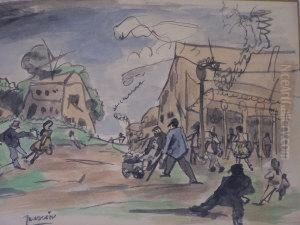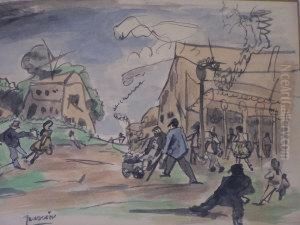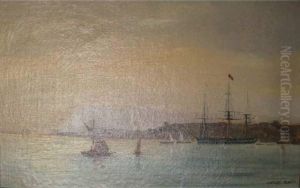Jules Alphonse Anthone Paintings
Jules Alphonse Anthone was a Belgian painter, born in 1848 in Antwerp, Belgium, and passed away in 1926. His life spanned a period of significant change in the art world, from the mid-19th century through the early years of the 20th century, a time that saw the transition from traditional academic art to more modernist movements. Anthone's work, however, remained deeply rooted in the academic tradition, reflecting the teachings of the Antwerp School, known for its emphasis on precision and technique.
Anthone was educated at the Royal Academy of Fine Arts in Antwerp, a prestigious institution that has nurtured many Belgian artists of renown. Under the tutelage of Nicaise De Keyser, one of the leading figures of the Romantic movement in Belgium, Anthone honed his skills in historical and genre painting. His style was characterized by meticulous attention to detail, vibrant coloration, and a keen interest in capturing the essence of his subjects, whether they were scenes from history, daily life, or landscapes.
Throughout his career, Anthone exhibited his works widely, both in Belgium and abroad, gaining recognition and praise for his contributions to Belgian art. Despite the onslaught of modernist trends that challenged the academic norms, Anthone's work remained popular among a segment of the population that valued the craftsmanship and narrative depth of traditional painting.
Unlike many of his contemporaries who ventured into the realms of Impressionism and Post-Impressionism, Anthone's oeuvre did not undergo radical stylistic shifts. Instead, he continued to refine his technique within the academic framework, focusing on the beauty of the natural world and the human condition. His landscapes and genre scenes, in particular, are noted for their tranquil beauty and delicate rendering of light and shadow, qualities that made his work appealing to collectors and the public alike.
Despite his success, Jules Alphonse Anthone has not achieved the same level of fame as some of his contemporaries. However, his dedication to the academic style and his ability to capture the essence of his subjects with clarity and emotion ensure his place in the annals of Belgian art. His paintings are a testament to the enduring appeal of academic art in an era of rapid change and are cherished for their technical skill and timeless beauty.


